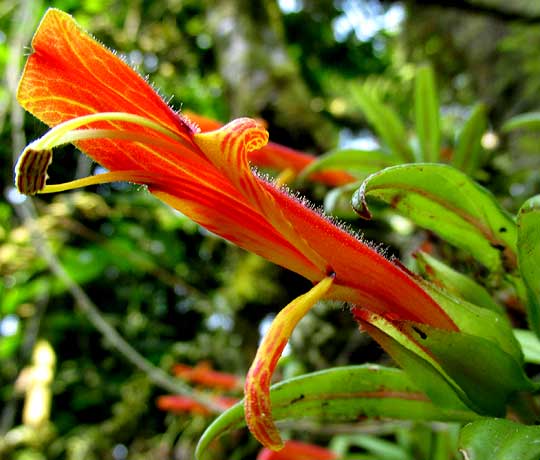Excerpts from Jim Conrad's
Naturalist Newsletter

from the May 17, 2015 Newsletter issued from Río Lagartos, on the Yucatan Peninsula's northern coast (~N21.60°, ~W88.16°), Yucatán state, MÉXICO
COLUMNEA PURPUSII
During the last week of April I camped in the mountain-top hydrological reserve above and to the north of San Andrés Tuxtla, Veracruz, Mexico (elevation ~1180m (5900ft), ~N18.52°, ~W95.15°.) Our page describing that reserve and showing a satellite view of the entire region is at www.backyardnature.net/mexnat/tuxtla.htm.
A gesneriad, or member of the African Violet Family, the Gesneriaceae, flowering in the mountain-top cloud forest there was the one shown above. Though growing on a tree epiphytically, this soft-woody plant wasn't a parasite on its host tree, but rather just grew there like the moss, lichens, orchids and bromeliads also populating tree trunks in this moist, shady environment. A close-up of one of the plant's interesting flowers appears below:

This blossom nicely displays characteristic features of gesneriad flowers: The corolla's lobes unite into a tube at its base; the corolla is bilaterally symmetrical, or two-lipped; the four stamens are attached to the corolla (they're "epipetalous"), and; the stamens are of two lengths (they're "didynamous"). The corolla's hairiness and bright color also are typical.
This is COLUMNEA PURPUSII, with no good English name. Not much information is known about it. From what I can see it's endemic to moist tropical forests just to the southern Mexico states of Veracruz, Oaxaca and Chiapas.
Though this species is not well documented, the genus Columnea is well known because it embraces about 200 species of the tropical Americas, many of which are popular ornamentals. The species are epiphytic and tend to trail, as ours is, scrambling over the tree trunk.